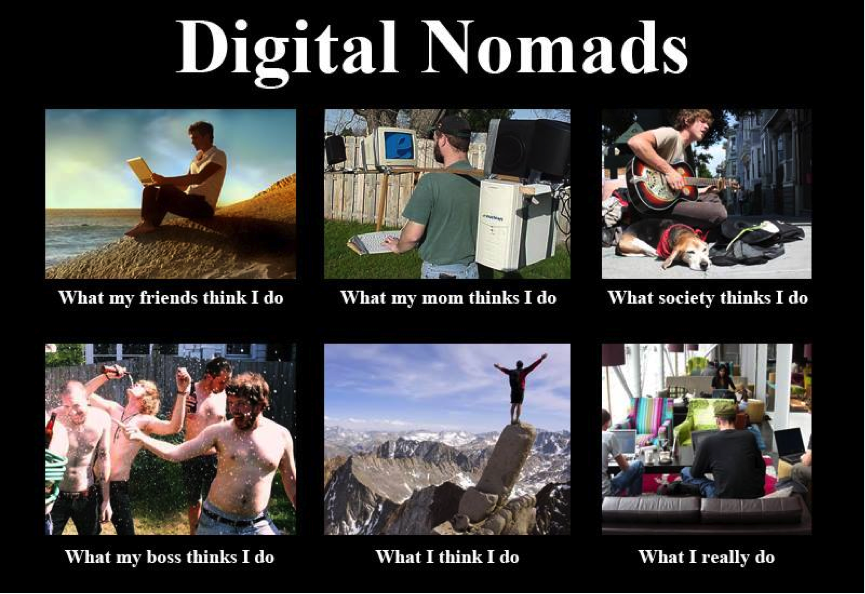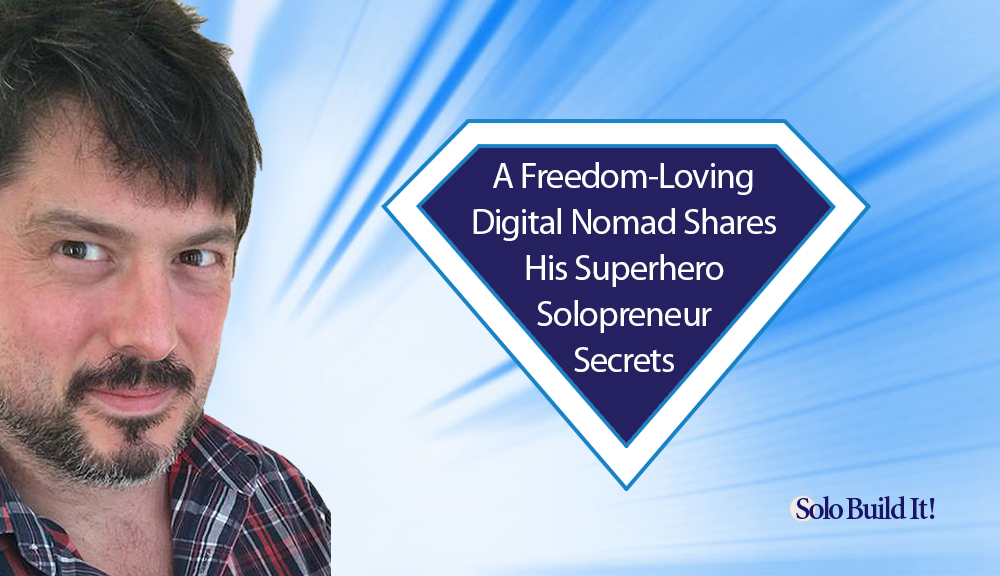
Freedom is huge. I have so much more of it being an online business owner.Ashley Cotter-Cairns
Tired of working to someone else’s rules, dealing with office politics and hours wasted commuting? Ashley Cotter-Cairns quit his full-time job in 1996. Only when he found SBI!, though, did a lifestyle of freedom become realistic.
In his late 20s, between leaving the workforce (he became a freelancer) and discovering Solo Build It! (SBI!), Ashley had to hustle to keep creditors at bay. He even sold his “teenage junk” on eBay to make some quick cash.
Funny how one thing leads to another. Hooked by his online income experience, he started dabbling in buying and reselling on eBay. And then, “D Day”…
“D” Stands for Discovery
Ashley’s real career as a solopreneur began in 2005, after he found SBI!.
The circumstances are one of those wild coincidences that are almost too weird to be true. He happened to live in the same village as SiteSell founder, Ken Evoy.
Everyone either knows everyone in a town of a few thousand, or knows someone who does. Ashley had heard of Ken and checked out SBI!. But why not get the lowdown straight from the horse’s mouth?
Yup, he called Ken!
“I knew this was real within just a few minutes of talking to him,” says Ashley. “That passion for setting people free by enabling them to succeed online is 100% real. I was in!”
His business breakthrough came when he returned to his childhood roots: his passion for comic books. Superman, the Hulk, you know… Who knew there was money in that?
Ashley did. And now he is writing his own superhero story. He has battled the super-villains of self doubts, cash flow shortage, poor deals and countless other enemies. But in true superhero fashion, he never gave up.
Want to become the superhero of your life story? Follow along. Ashley shares priceless tips and advice below.
1. Ashley, your site www.sellmycomicbooks.com isn’t your first online business. In fact, you’ve been with SBI! since 2005. Can you share some of the lessons you’ve learned, from your first steps as a solopreneur to today?
Wow! Time flies. Where do I begin?
This question almost feels like the last one you should ask me, because I’m going to risk sounding like I’m preaching from a soap box with this story.
Let’s begin with this important statement: I’ve never left SBI!. And I own several SBI! sites. I know Ken discourages owning a bunch of sites because “one business is more than enough.” So don’t tell him I don’t listen too well, heh heh.
That said, all my sites are SBI! sites, barring a couple of experiments with WordPress.
If you prefer WP, check out SBI! for WP here.
SellMyComicBooks.com is one of them – it’s my total focus. Fellow professionals and coaches often ask, “Why are you using this website platform instead of WordPress?” The simple answer is, “I am familiar with it, it suits me, it works, why change?”
 The longer answer is, going from SBI! to WordPress is like running a road car for years. You have an SBI! mechanic looking after everything that you (meaning “I”) don’t want or need to understand.
The longer answer is, going from SBI! to WordPress is like running a road car for years. You have an SBI! mechanic looking after everything that you (meaning “I”) don’t want or need to understand.
Then suddenly, you decide to order a kit car and try to assemble it yourself. And at the same time you’re still trying to drive it. Why the heck would I want a kit car?
Figuring out which pieces you need and how to put them together is a massive drag on your time, the most precious resource of all! Few people understand that most solopreneurs fail for two reasons… Yes, they both boil down to TIME.
1) they don’t have enough time to do it all
2) they don’t have time to figure out the perfect process.
 SBI!, on the other hand, comes as an all-in-one package of process, software, guidance and help. You’ll have everything you need to not just build a web SITE, but a thriving web BUSINESS. And SBI! for WordPress takes care of “everything WP,” too. Just like the original version (and McDonald’s)… “we do it all for you.”
SBI!, on the other hand, comes as an all-in-one package of process, software, guidance and help. You’ll have everything you need to not just build a web SITE, but a thriving web BUSINESS. And SBI! for WordPress takes care of “everything WP,” too. Just like the original version (and McDonald’s)… “we do it all for you.”
Here are my ABC’s that I’m happy to share with solopreneurs…
- Right from the start, become a professional. Dedicate yourself to this process. Remind yourself daily that you are not building a web SITE. You are building a web BUSINESS.
- Be stubborn, within limits. Don’t become discouraged in the early months. If you can, aim to add a page of content every two or three days. Better still, every other day. If you are really doing everything right, you should be getting about 100 visitors per day after three months or less.
- If you don’t, and you’re concerned, the Solo Build It! forums are a great place to go for advice. They are filled with supportive, experienced people who are ready and willing to “pay it forward” (one of SiteSell’s main concepts). I asked for, and received, massive help there when I was starting out.
- Immerse yourself in your niche. This is unnecessary advice for anybody who is passionate and wants to monetize their passion with an SBI! business. Unless you “just want to make a bit of extra money online,” you need to get obsessed and stay obsessed.
- For your content to be the best — so good that your visitors click a “share” button — you must become an expert in the topic that an individual page tackles. It doesn’t take the world’s greatest site on any topic to make a very good living. You just need to be great in a limited part of your niche – the niche within the niche, so to speak.
What about the great outdoors, beyond SBI?
I would say that the SBI! Action Guide is excellent at keeping new solopreneurs on the straight and narrow, and that is essential at first. SiteSell’s founder, Ken Evoy, rightly points out that there’s a lot of noise out there — lots of ways to get overwhelmed, to buy shiny new things (that never get used), to become distracted from what’s important.
There may come a time when you need to go beyond the Action Guide. The problem is — and this is why Ken was always been so adamant about “keeping the blinders on” (sticking to the Action Guide and working within the SBI! community) – it’s too easy to have your head turned by all those great offers in the internet marketing space. At first, you don’t really know what’s going to be good and what’s not. You’re sort of on your own. You can potentially lose a lot of time and money doing this..
Reality looks different though. Building a profitable business takes hard work, determination and focus. SBI! is all about helping you focus on what counts most… your business. The Action Guide and SBI!’s tools are constantly updated to keep SBI! members ahead of their competition. We track hundreds of blogs, newsletters and social media so that SBIers don’t have to try to figure it all out. They get only the best info, tucked into the system for the moment they need it, keeping them distraction-free, focused 100% on growing their online business. You’re covered whether you are a complete novice or have been following the Internet marketing area for years.
My best experiences are when I bring back something from the wider internet marketing space that I can apply within the framework of my SBI! businesses. That’s the win-win.
Here’s one example: Recently I went to an e-marketing conference and learned some advanced Search Engine Optimization (SEO) tips, such as a concept called “broken link building.” I knew how to evaluate that – there was nothing unnatural about it. I’m not black or grey hat. I filter what I hear through the lens of “keep it real” and “deliver what humans and Google want,” two of SBI!’s founding principles.
2. How did you settle on your niche? How did you know it was the right one?
Well, here’s the thing. You don’t really choose a niche. A niche chooses you. (I’ve begun blogging the story of my education in the comic book business at theashman.com.)
The roots of my comic book business are in my childhood, when I would read anything within reach. By the time I discovered comic books, I had twin baby brothers and an overwhelmed mother with not much time for me. So I read anything and everything I could get hold of, including vintage Marvel and DC comics bought for a penny each at a local antique store.
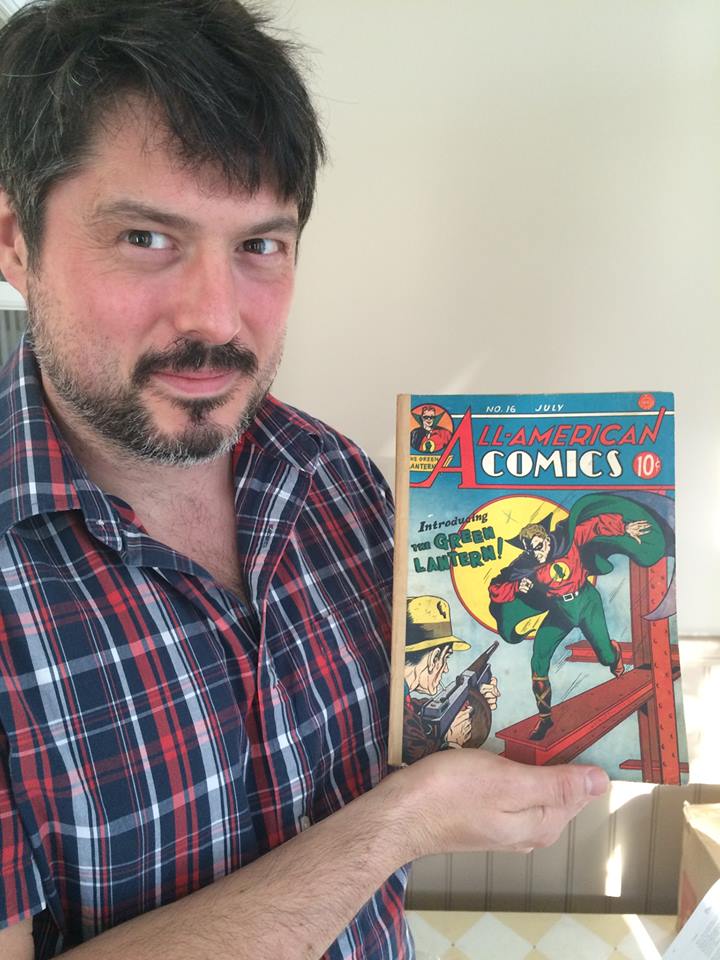
In his case, it’s comic books. What’s YOUR passion?
A few years later, my friend Julian and I would watch Batman reruns on TV. I’ve had a soft spot for superheroes ever since.
In my late 20s, between leaving the workforce to be freelance and discovering SBI!, I was in a cash crunch and started using eBay. By the time I sold off my teenage “junk,” I was hooked — and began buying more junk to sell on eBay!
Fast-forward to 2005. I discovered SBI! and began my education in online business building.
I built or owned about 25 SBI! projects between 2005 and starting “Sell My Comic Books” in 2012. Some were partial successes, some abject failures, some time drains. I sold some, some closed down. I still own several, but they rarely occupy my mind these days.
People don’t factor in the time that they lose by starting many sites. Think of it this way… Wouldn’t you rather focus all your time on one highly profitable business than 10 ineffective sites? The SBI! philosophy is simple… your time is precious. We fight to get the most out of every second you invest. You would never start two or more brick-and-mortar businesses at the same time, right? Too “dollar-expensive.” Trying it online is too TIME-expensive.
In one of my experiments that the SBI! team warned me against — using a third-party software suite to build apps for Android phones — I created a comic book investment app. It made me the grand total of, literally, several dollars per month!
However, it did reignite my interest in comic books, which led me to wonder whether the time was right to look at a new direction for my business.
At this time, I had around ten SBI! sites. My plan had been to buy existing SBI! sites and improve them, to build a portfolio of passive income businesses.
(I still think that strategy is a good one. I recently bought an SBI! site as a passive income investment. I only paid $1,000 for it and I’ve already earned back $440 of that from AdSense. But it’s not the main event for me.)
The issue was that the jump between portfolio sites was too great. Sites of interest to me were in the $10,000 to $20,000 range, and it just wasn’t easy to find that kind of money when it was time to level up.
Also — and this is what I meant about a niche choosing you — it’s hard to get excited about improving a site that doesn’t speak to you. How do you bring the passion you need to make the content exceptional?
I began buying comic books to resell on eBay and through auction companies. But soon, I recognized that it would be much easier to buy collections if the books came more directly to me.
So I began building www.sellmycomicbooks.com to free me from the need to trawl through Craigslist and eBay. By generating my own traffic and leads, I would “own” the opportunities.
“It would be much easier to buy collections if the books came to me.” Bingo! How did he do it? He followed SBI!’s proven Content First, he provides the Content that prospective comic book owners / sellers are looking for. His high-quality topical content gets found (search) or discovered (social), attracting free targeted Traffic (aka interested visitors). Once on the page, his visitors are hooked because Ashley over delivers… he presents the best possible answer to what his visitors are looking for, in a unique “been there, done that” voice. This PREsold visitor is happy to sell his comic book collection to Ashley, who then re-sells it for a profit. He Monetizes! Superhero mission accomplished. It took a long time to corral our superhero, super-curious SBIer into C![]() Traffic
Traffic![]() PREsell
PREsell![]() Monetize concept.
Monetize concept.![]() T
T![]() P
P![]() M, but when it happened, he never looked back (he’s probably looking around, though 😉 ).
M, but when it happened, he never looked back (he’s probably looking around, though 😉 ).
Things were going okay. After three or four months, I was offered my first big collection. Although I didn’t manage to acquire it, that was proof enough that the process was going to work. So I doubled-down and kept going.
Again, I repeat that it’s important to treat your SBI! project as a business. The reason I didn’t get that first big collection was lack of access to quick cash. So rather than just write it off as bad timing or bad luck, I learned a lesson from that experience and sought credit from different banks.
(These days, my business partner and I use PayPal Working Capital to bridge any shortfall in cash flow.)
It took almost exactly one year between starting Sell My Comic Books to getting my hands on my first major collection. It was a very rough condition one, but included hundreds of 1960s books, including copies of all the best stuff, like Amazing Spider-Man #1 and Incredible Hulk #1 (see the image below – it was complete, but a stinker). This was a real thrill!
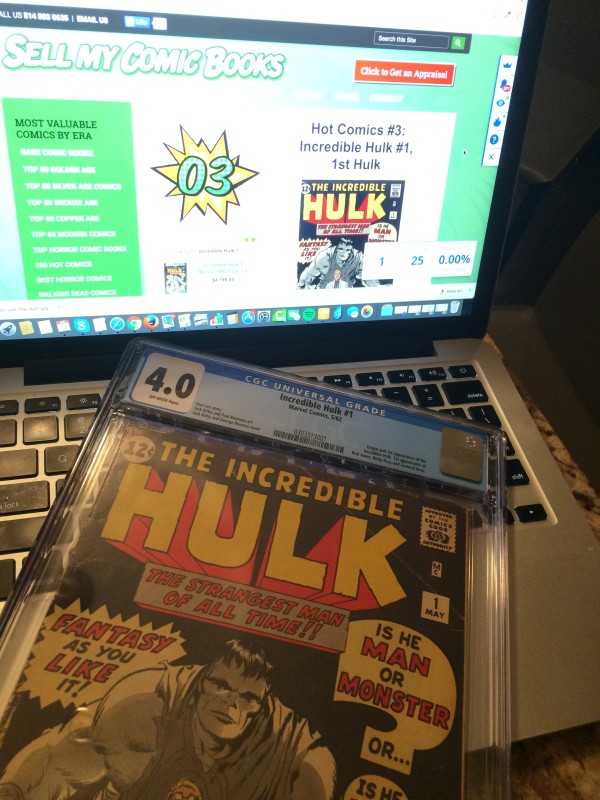
Want some good advice? Pay attention. This is important.
YOUR BUSINESS might not need cash to operate day-to-day like mine does. But there are going to be missed opportunities, which present lessons you need to recognize and learn if you are going to succeed.
Whenever you’re frustrated and stuck, there is a learning opportunity staring you in the face.
Where is your “cash crunch”? What is stopping you from “buying the big collection” in your niche? Recognize your weaknesses. Plan to work around them next time opportunity knocks, and arm yourself with the “credit” you need to overcome that challenge next time.
I know that sounds very blue-sky and Zen, but I’m not going to break it down for you. Sometimes you need to figure out what, exactly, a bozo like me means when he says stuff like that. 😉
That said, we cover hard goods as a monetization model. Ashley’s lesson DOES apply here. You need to have the cash to build up some inventory. More importantly, Ashley has the right attitude to succeed. If there’s one characteristic that all the successful solopreneurs we’ve talked to share, it’s what we call “BAM“… Brain – they have experience/knowledge in a field that others would want Attitude – they have a positive attitude/ability to bounce back, and Motivation – they persist, hanging in until they win. Ashley has so much BAM, we’re surprised he doesn’t explode!
3. Tell us about your philosophy regarding content. How do you know what your prospective customers are looking for? Where does this information come from?
Content drives everything else I do. You can have an entire business built totally on content marketing, never need to build a link, send a newsletter, lose any sleep about so-called advanced marketing concepts.
But you’ve got to be obsessive about making your content the absolute best at what it does. A good sign is when you begin outranking Wikipedia for your keywords!
Research: The obvious aide to my research is Brainstorm It! (BI! – one of the main assets of Solo Build It!). It tells me what my customers are looking for. So interpreting BI! data through knowledge and experience is where my content ideas come from.
In practice, you can’t really know which will be your best-performing pages. When you make your content blueprint, you’ll look at it and say, “For sure, THIS page will be a winner.” Then some bizarre random page that didn’t excite you anything like as much gets near the top of Google’s results, and drags other pages up with it.
Earlier I said that your niche chooses you. When that happens, immerse yourself in it until you live and breathe that niche. That’s how your knowledge and excitement will shine through in your content. Visitors will recognize the difference between you and everybody else.
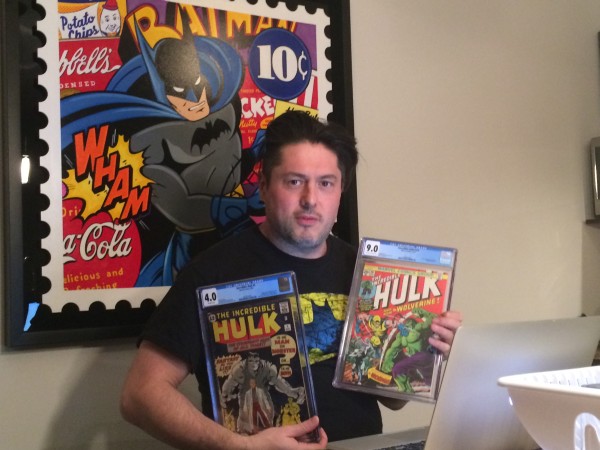
When you get unsolicited emails congratulating you on your site’s content, it’s a sign that other people feel the same way. It’s time-consuming to show appreciation for somebody’s efforts. When I get an email like that, I know the person was REALLY struck by my content. Typically, people don’t take the trouble to do things unless you guide them.
Which is why you should not allow the argument, “There are so many other sites out there doing this” to deter you. Content is like falling in love. When you know it’s right, it’s right.
But, as Ashley says, don’t let competition deter you from starting a business in a niche you know and love. The SBI! Action Guide shows you how to…
I’m always improving my existing content. Not tweaking to get some artificial bump in ranking for that keyword, but actively improving. If a page is two or three years old, it’s time for a spring-clean. How can you build on that already-popular page by making it even better?
Improve images, update information, expand it with yet more great data or advice.
For example, one of my most popular pages has improved across the board. It has 18 percent more page views, 37 percent longer time on page, 23 percent more visitors entering at that page. Why? Because I spent about 12 hours developing it from 20 to 60 comic books. Anybody looking at that page and hoping to outrank me now has a much tougher job.
Content is your greatest investment. Do it right and it will repay you for decades.
The rest will fall into place.
4. You provide lots of information and resources for free. How do you “upgrade” people from being free content seekers to paying customers?
You ask them for money! I know that sounds obvious, but…
IF YOU DON’T ASK, YOU DON’T GET.
Let me clarify. Don’t build a product and dangle it like bait in front of your visitors. That sucks, and they’ll know it.
Instead, look at what content they consume (Google Analytics is a vital tool in assessing this, especially as traffic increases), and find ways to repurpose that content as fee-paying digital products.
There is more than one way to turn a visitor into a customer.
In Ashley’s case, that’s buying comic book collections and re-selling them for a profit. Others may sell services or online courses or focus primarily on AdSense and affiliate marketing (i.e., passive monetization). When your primary monetization model is well underway, watch for opportunities to add secondary income streams. These, too, are pre-planned. You should plan your big picture of monetization in advance. The details and twists present themselves as you go.
Our traffic is schizophrenic. About half the people come to sell us comic books. That’s why the site was built in the first place. But many others come to refer to our content before BUYING stuff on eBay.
They click on an affiliate link, and I get a piece of anything they buy during their eBay shopping experience.
Before long, eBay commissions were $100 per month, then $200, then $300. It was growing all the time.
That led to me wondering whether I could be making more eBay commissions by actively encouraging people to buy more.
Now I have eBooks full of investment tips for comic book buyers. I charge for the eBook ($7 typically) and people who buy it have a document full of my affiliate links. If they take the advice in the eBook, they will buy the books I’m suggesting. And that earns me money for as long as they use it.
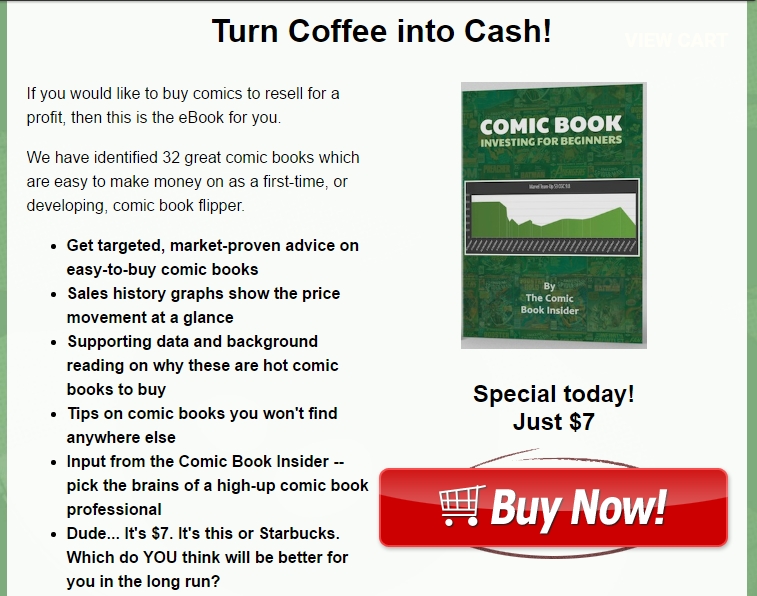
I have also built a mailing list. My newsletter is sent about every ten days and contains more tips and advice. It has links to eBay, but also back to my site. I then have a chance to get repeat visitors, or sales through eBay links.
The key is to think like your visitor. Imagine their pain points. Try to anticipate what it will take to make them get out their wallet and pay you for your expertise.
If in doubt, put surveys on the site and ASK YOUR CUSTOMER WHAT THEY STRUGGLE WITH. Their answers will provide you with both content and product ideas. And the language they use will help you to craft sales pages exactly expressing their desires.
5. In 2016 you made $41,000 CAD from eBay affiliate commissions alone. That’s quite impressive! What other income streams do you have?
Our biggest income stream by far is reselling the comic books we buy from customers. We net more than $100,000 after expenses.
My business partner is in charge of the selling operation — and it’s no exaggeration to call it that, as we have recently opened an office, and hired three staff.
I do all the buying. As I am reading through list after list of comic books, I can actually visualize the covers of hundreds of the most important books. They are the ones I’m looking for.
And now that we have staff, I’m able to buy more widely. I know that, whatever I buy, the team will sell it sooner rather than later.
I’ve experimented with selling ads on the site (mainly Google AdSense). But I’m loathe to allow a visitor to click a link and end up on another dealer’s website. The pennies we get for the click might cost hundreds or thousands in lost profits.
Those who follow that advice find much higher-paying monetization models.
We also have several digital products, but I’d rather give those away for nothing and earn on the back end from sales through eBay affiliate links.
I’ve sold about $1,400 of eBooks this year, and nearly $1,000 of video courses. That’s really not very much. But that’s fine, because the main purpose of these products is to generate income from other sources.
Still, that little bit of income does make me wonder what I’m leaving on the table. But if I take my eye off the ball, the selling team won’t have new stock to resell.
So on the whole, I think the balance is about right. eBooks, video courses and eBay sales commission are almost exclusively passive income, and it’s a nice extra that pays my rent, keeps me fed, puts gas in the car and clothes on my back, without any real effort.
6. How long did it take to start earning an income from your site?
Fortunately, my other SBI! businesses were paying our way when I began Sell My Comic Books. So there wasn’t desperate pressure for it to perform from day one.
It was never meant to be a passive income machine. The goal was to bring in leads to collections I could buy and resell for profit. That distinction makes this a difficult question to answer.
Within a year, I’d landed my first major collection, at an investment of $3,000, which resulted in total sales of between $10,000 and $12,000.
Without circling back to check figures, I might have been bringing in a bit of AdSense or eBay income by that time, but the numbers didn’t get interesting until the second year.
Now it’s a full-time income for myself, my business partner Sean, and two full-time employees, plus a part-time shipping assistant. And, as I mentioned, our profit is into six figures after salaries and costs.
We’ll probably have to hire again in the next six to nine months if things continue to grow.
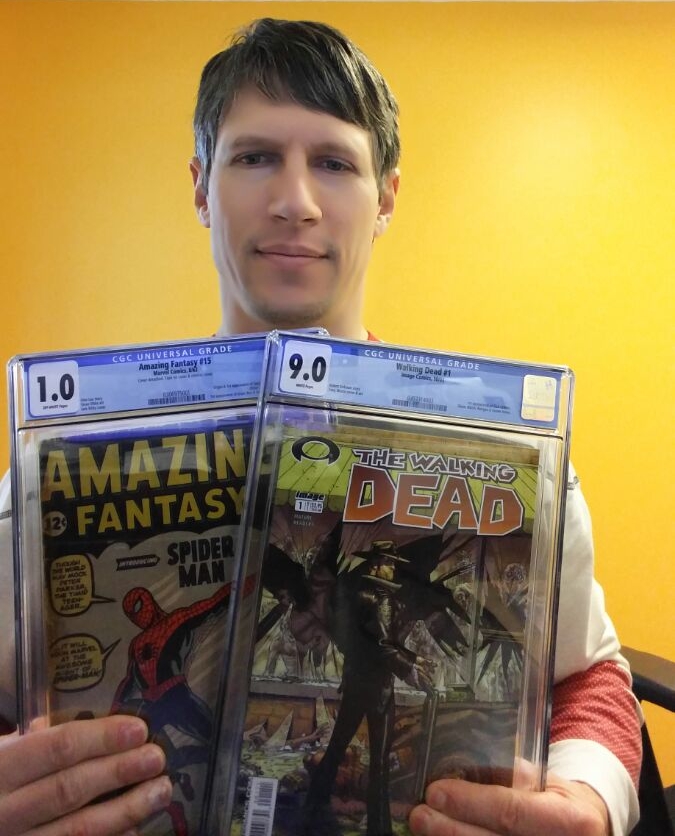
7. You’ve told us about the staff you now have. How many hours per week do you personally put into your online business?
I have a personal Virtual Assistant (VA) based in Las Vegas who handles some of my load. She takes courses or reads books and summarizes them for me (major time-saving tip!). She also researches restaurants and nightspots in cities I am visiting for the first time, or digs into topics that interest me but which might become a time-sucking rabbit hole.
As with many solopreneurs, the number of hours per week I work varies. It depends on whether I’m creating new content or improving old content, and on how many emails I need to answer.
I work at least 30 hours per week, unless I am traveling. At a recent conference, I met several people who were fascinated by my story. One of them said, “I’m jealous! You’re a digital nomad. That’s my dream.”
I’d never heard the term before, but essentially it means all I need is a laptop and wifi, and I’m ‘at work’.
someone who derives income remotely and online, rather than from commuting to an office. This enables the digital nomad to not need a permanent home base, and she/he can travel anywhere at any time. It doesn’t say much about the type of work you do. You could still be an employee, or offer your freelance services via UpWork and the likes. A solopreneur like Ashley is much more than that. He runs his own business. He sets his own schedule. He can choose whether to do this from his home, a coffee shop, a co-working space or an RV. We prefer to call this “business without boundaries.”
On a recent trip back to England to visit friends and family (and to buy a small collection — business never sleeps!), I spent just 1-2 hours every second day on making deals via email.
I didn’t beat myself up about not putting in a big workday — I was on vacation, after all. And I didn’t beat myself up about working on my vacation, either. It’s a great privilege to be a digital nomad, but there are four people in the United States relying on my deal-making to keep the operation running.
Work-life balance is always a challenge. When you are totally committed to the process, there are never enough hours in the day. But it’s important to recognize that you have other needs. Make time to exercise, travel, socialize, read, and relax.
Smartphones are wonderful, but they are also ties that bind you to your business. If you allow it to, your SBI! business will interfere with everything else you do. Learn to ‘close the office’. Tomorrow is another day.
8. What are your major priorities and business goals for the next 12 months?
I want to continue to invest in myself. I am my business. If I’m not working well, then neither will it.
Not all the investment in myself is business-related. It may be meditation, learning a new, unrelated skill, or therapy. Therapy was big for me. It helped me to let go of baggage, to ignore sunk costs in my personal life.
I try to get to three or four live conferences or events every year. It’s nice to mingle with people who speak the same language. You can talk CTR (click through rates) and bounce rate without having to explain every term, or suffer people’s eyes glazing over before they do that sideways-look thing as they seek a way to escape from your nerd gravitational pull.
For a regular exchange of ideas, tips and motivation, join a forum of online business builders like the Solo Build It! forums. You’d be hard pressed to find a more helpful community of solopreneurs.
It’s also cool to say I’m a comic book dealer. But that will change from now on, because I’m using the success of the business to allow myself to focus on my talent as a writer.
In the future, I will introduce myself as a writer. That’s not where the MONEY comes from, it’s where the ART comes from. Important distinction. The world is full of money, but art is priceless.
So personally, I want to work on my novels every day and travel a bit more. Not necessarily big trips, maybe four or five days here or there. I want to take courses, not just for my business but also ones which will expand my personal horizons. I want to be open-minded to the new direction my life is taking, and enjoy my success.
That’s a big one. People get so focused on achieving success that they forget to make the most of it when they have it. Like climbing a mountain. If you don’t look at the view from the top, what’s the point of going to all that trouble?
9. What has been your biggest challenge so far as a solopreneur?
Learning to let go of things and stop worrying about them. I took a course under one of my heroes, Seth Godin (a thrill — altMBA 7). A big take-away from that was, “Ignore sunk costs.”
One of my worst deals when I was trying to build a portfolio of passive income sites was HolaGalapagos.com. I didn’t do enough due diligence, and the whole process was flawed. I didn’t understand the travel market, I wasn’t able to afford a trip to the islands to research, and we borrowed the money to buy it at an expensive interest rate.
I’ve since learned to let go of everything that isn’t a positive, and accept that over the years the site may eventually repay the investment through AdSense. But the purchase, the time and money spent on improving it, etc. is a sunk cost.
That money isn’t going to come back to me today or tomorrow, and I have better ways to spend my time than agonizing about it.
Ditto for third-party tools, coaching or courses that have not yielded the hoped-for results. I’ve personally invested $40-$50,000 in courses, conferences, coaching and other learning. All that has made me a better solopreneur. How could it not?
But trying to put a dollar value on the Return on Investment (ROI) is impossible, and an exercise in futility. It’s not as simple as saying, “I invested $50K in an MBA at Harvard and now I have a job paying $150K per year.” Looking back, I would delete the average or disappointing things I paid for, and only take the good ones. But we’re all richer with 20/20 hindsight.

I will continue to take advice, go to conferences, follow courses and invest in my skills, because every so often one project or person or book or video will out-perform everything else, help me to level up. And there is no way of knowing beforehand which one will do that.
10. And finally… What do you enjoy most about being an online business owner? How has it changed you, your life, your family?
Freedom is huge. I have so much more of it being an online business owner.
I quit my last full-time job back in 1996. I was just tired of the BS of working to somebody else’s rules for no good reason, office politics, and all the time I wasted commuting, an hour there, an hour back every morning and night.
It’s exactly 20 years to the day that I handed in my notice there. If I was still doing that job today, I’d have spent another 12,000 hours in my car driving to and fro. That is 500 24-hour days of my finite life, tired, stressed and not doing what I wanted, looking up the tailpipes of thousands of other commuters.
There is nothing better than working when and where I want to. The money is good, but the freedom to throw my laptop and a couple of T-shirts into a bag and fly off somewhere is awesome.
Do what you love. Love what you do. No better advice out there at any price.
He has pushed beyond “solopreneur” to become an entrepreneur. Ashley will go on to even bigger and better things. Ken gets the final words on this one… I still remember the day he called me out of the blue. His energy was infectious, his mind bounced around on various ideas and he was clearly determined to live life on his terms. I’m so happy that he’s well on his way. Having had a chance to channel that much energy into a more focused approach is a great privilege for us. Every SBIer is different, but in another sense, they’re similar. They all have BAM. It excites me that they get what they deserve out of SBI!. It’s a huge thrill for everyone here at SiteSell. Most solopreneurs crash on the obstacles out there. The failure rate is dismal. BAM is not enough. Ashley is bursting with it and has channeled it well. What comes next? Ashley has freedom to make his own work-life balance decision. What a ride… He’s free!
Key Takeaways
- Repeat this mantra to yourself, daily: I am building a web BUSINESS, not a web SITE.
- Immerse yourself in your niche. To succeed with your online business it’s better to go deep than wide.
- Don’t get distracted by Internet marketing noise. Stay focused on what’s most important for your business, at any given time. SBIers have the SBI! Action Guide to keep them on track.
- You’ve heard this one before, but it’s so important that we’ll repeat it: Choose a niche you are passionate about (or, as Ashley puts it, let the niche choose you).
- Whenever you’re frustrated and stuck, there is a learning opportunity staring you in the face. Ask yourself: Where are my weaknesses? What can I do to push my business forward?
- Make your content the absolute best in your niche. You know you’re doing it right when you get emails from readers congratulating you on your content.
- Stuck for monetization ideas? Analyze what content your visitors love most and find ways to repurpose that content into paid digital products.
- Recognize new opportunities. Ashley’s business concept was to buy comic book collections and re-sell them for a profit. This still is his main income stream. But he also noticed that many of his visitors used his site to research before buying comic books on eBay. So he created eBooks with investment tips for this audience, weaving in his eBay affiliate links.
- Keep your work-life balance in mind. As an online business owner, you’re always “at work.” Consciously make time to exercise, travel, socialize, read, and relax.
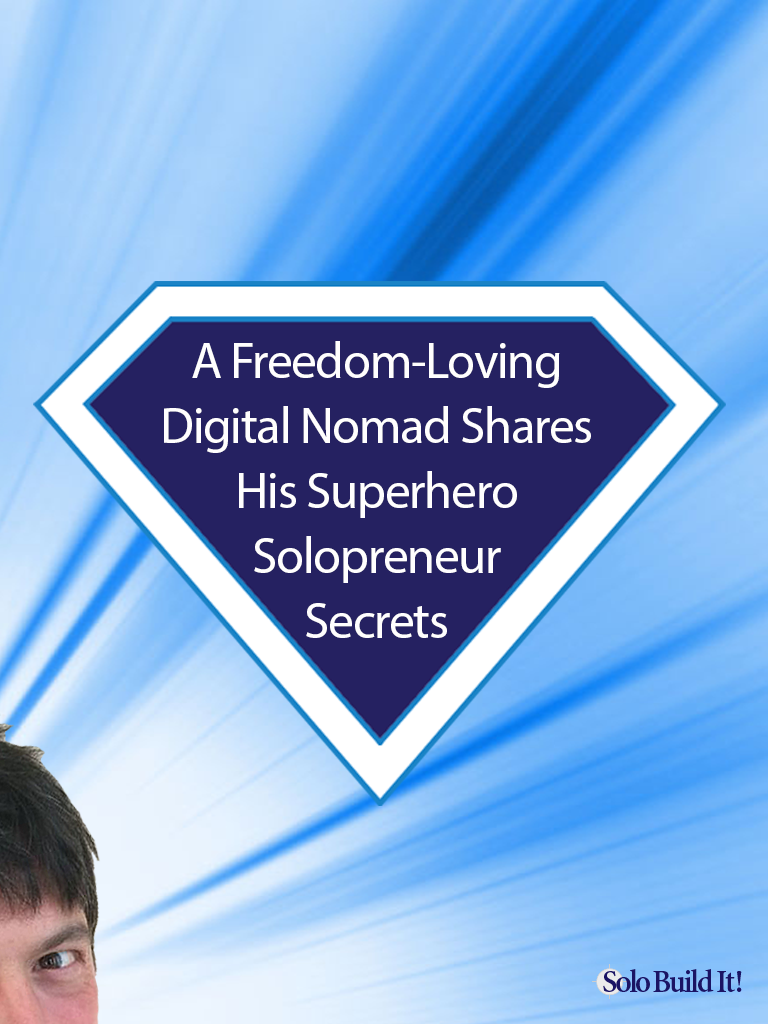


Latest posts by Ashley Cotter-Cairns (see all)
- A Freedom-Loving Digital Nomad Shares His Superhero Solopreneur Secrets - January 26, 2017


